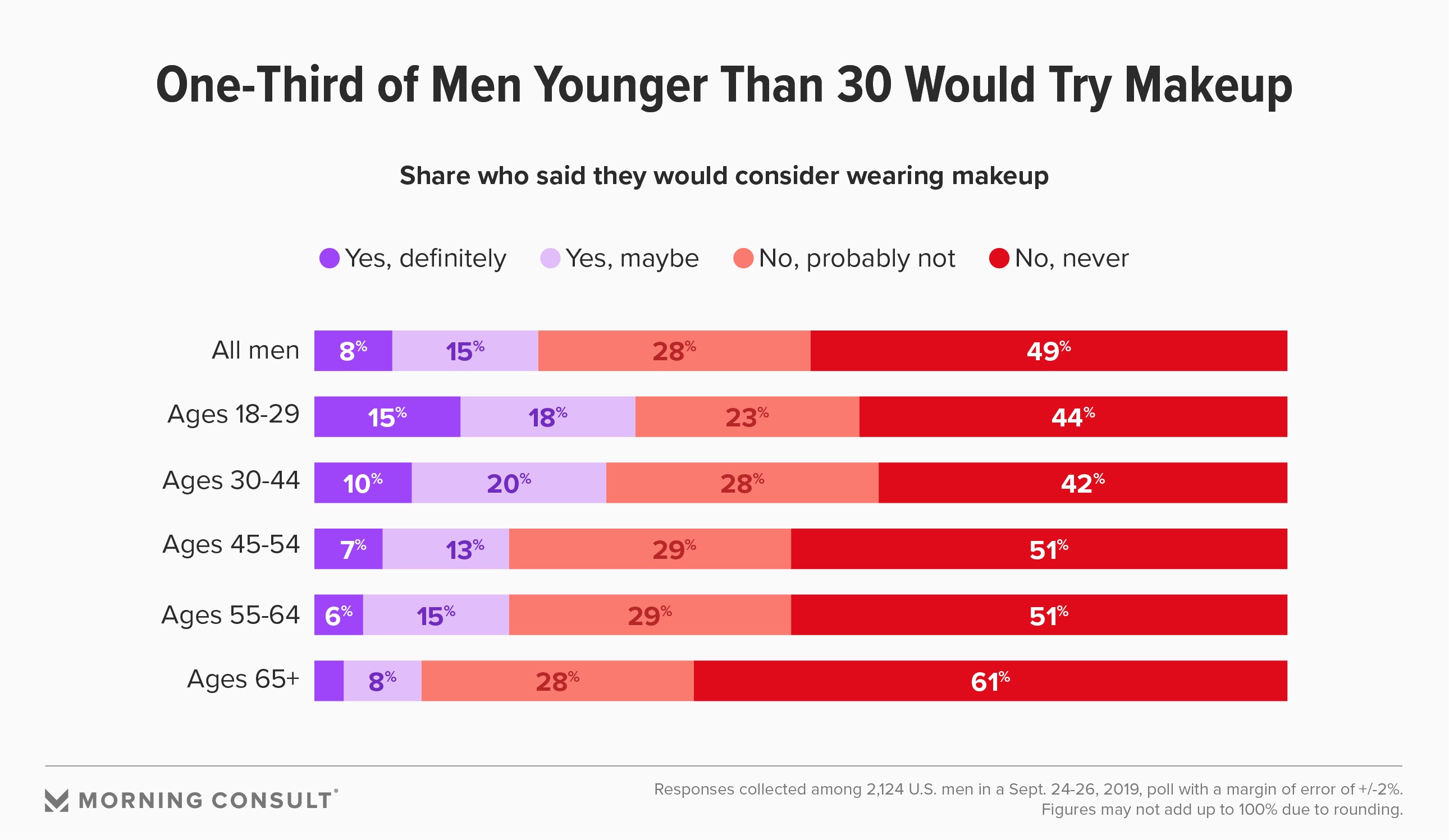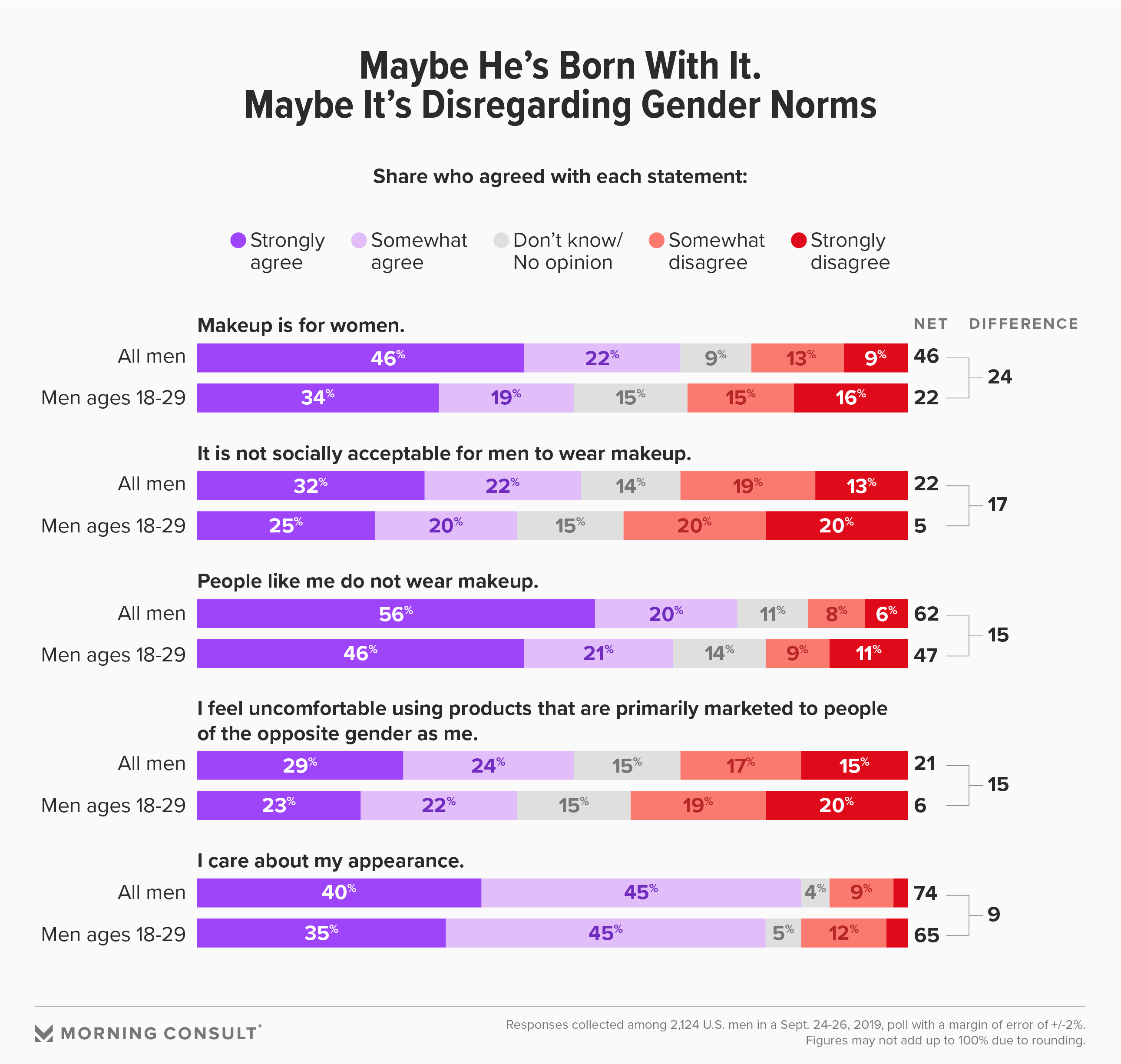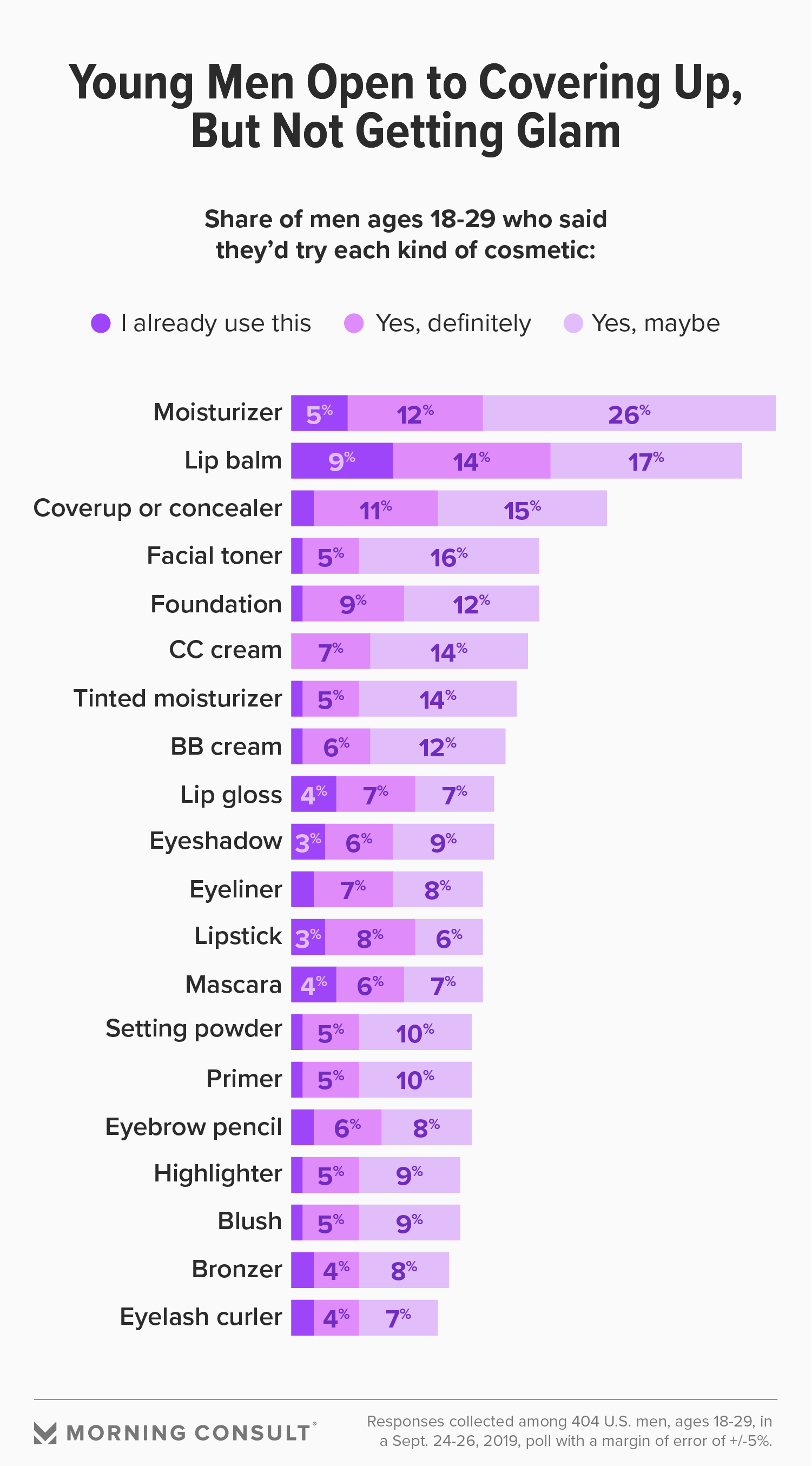What Percentage Of Americans Wear Makeup
Brands
As Dazzler Norms Blur, One-Third of Immature Men Say They'd Consider Wearing Cosmetics
Men's makeup brands say stigma has fallen as ascension of social media fuels interest in appearance-enhancing products



Getty Images / Morning Consult illustration past Samantha Elbouez
Come up on boys, vogue! The youngest generation's greater willingness to embrace nontraditional gender norms has opened up a new market inside the beauty industry: men's makeup.
One-third of young men said they would consider wearing makeup, according to Morning Consult polling, while 23 percent of all men said the same. Founders of men's cosmetic brands credit the increased interest among young men not simply to a wider acceptance of the idea that gender is fluid only too to the pressure to be flick perfect at whatsoever moment, thanks to social media.
"The stigma associated with buying and purchasing this product is starting to diminish," said Andrew Grella, founder and CEO of the men's makeup brand Formen Inc., with the country'due south youngest consumers taking up the pall of socially normalizing men'southward utilise of cosmetics.

30-iii percent of men ages xviii-29 said they would consider wearing makeup, while another 30 percent of men ages 30-44 reported said they'd be open up to the idea as well. The information collected from 2,142 men in a Sept. 24-26 survey of four,400 U.S. adults has a margin of mistake of 2 percentage points.
Men have dabbled with makeup throughout modernity, only it's just recently that men'southward cosmetics has slipped into the mainstream. In August 2018, Chanel debuted a line of men'due south makeup, chosen Boy de Chanel, that includes a foundation and an eyebrow pencil. CoverGirl named social media influencer James Charles as the offset male person face of the brand in October 2016, and Maybelline followed suit three months later when it made Manny Gutierrez, another influencer, as its beginning male New York administrator. A Google Trends graph of online searches for "men'due south makeup" shows a greater interest in the topic in the last few years.
"The ascent of social media, and only the ubiquity of it, should not be underplayed," said Devir Kahan, co-founder of the men'south makeup brand Stryx. Every moment is capturable — and postable — for the generations who accept grown up with smartphones in their hands and new definitions of privacy.
"Y'all're taking selfies and sharing videos and on FaceTime — meaning you never know when you're going to need to be 'camera ready,'" Kahan said.
The anonymity and discretion that comes with online shopping, which nonetheless only accounts for almost 10 percent of all retail sales, has besides helped fuel the sub-industry, Formen's Grella said.
However, he'south now seeing a segment of male consumers ready to emerge from the privacy of their bathrooms and shop in spaces, such as pop-up stores or stand-alone shops, specifically meant to sell makeup to men.

Immature men'southward attitudes about beauty differ from their male peers overall, according to the survey, although there's widespread agreement on caring about i's advent. Men ages xviii-29 are more likely than their elders to reject the thought that it'south taboo for men to wearable makeup and they are less probable to report discomfort over using products primarily marketed toward the opposite gender. Younger men are also 15 points less probable to concur that makeup is for women.
Male influencers who utilize makeup are likewise becoming more prevalent. Six of the 25 top beauty influencers on a February 2019 listing from Izea Worldwide Inc., a technology platform that connects marketers with influential content creators, were men. That included makeup maven Jeffree Star, who was among the highest-paid YouTube stars, co-ordinate to Forbes' 2018 ranking , with $18 million in earnings.
But there's an important distinction between the makeup tutorials Star creates and the products sold by brands such every bit Formen and Stryx. Star normally wears a full confront of makeup, precious stone-toned eyeshadows and fake nails; the products sold by nearly men's makeup brands are strategically low-key and largely used to cover up "imperfections."
"We're doing products that fix the issues on the face" such as scars, discoloration or everyday blemishes, said Grella.
Formen sells seven individual products, including four corrective items: two concealers, blotting pulverization and CC (color correcting) cream. Stryx offers two products, a concealer and a tinted moisturizer. Both are straight-to-consumer brands, and prices are roughly reflective of cosmetics for women from DTC companies.


Male consumers like this more subdued approach, according to the poll: Coverup, concealer and tinted moisturizer ranked high in a list of products men would try, while feminine staples such as blush and mascara ranked lower.
No major drugstore make carries a line of makeup specifically marketed to men, fifty-fifty CoverGirl and Maybelline. Twenty-three percent of men said they'd exist more likely to try makeup if brands had defended products merely for men, and xviii percent said they'd be likely to try it if stores had defended employees to explain and exam men's makeup.
Although new perceptions of gender — more than specifically, the greater acceptance of gender fluidity — accept too opened the door to immature men'due south greater acceptance of more traditionally feminine products and services, marketing for cosmetics for men still retains a heavily masculine sensibility.
For example, British male cosmetics line War Paint used a promotional clip in May that featured a toned and tattooed man putting on a skull ring afterward applying the brand's eponymous makeup. (The video faced criticism for promoting "toxic masculinity" and has since been taken down.)
Sales in the men'due south personal care market are projected to see steady growth, reaching $4.five billion this twelvemonth in the United States, according to a September report from market research firm Mintel Grouping Ltd. The report said sales are primarily driven by products such as shampoos and deodorants only predicted that brands would benefit from a "new prioritization presenting a healthy advent." Globally, the industry is set up to achieve $166 billion by 2022, per an October 2016 Centrolineal Market Research study , with a chemical compound annual growth rate of 5.4 percent between 2016 and 2022.
Educating men about products and getting guys to experiment volition be primal to growth of the makeup category, Grella and Kahan both said, and re-familiarizing men with products that they know of but never thought were suited for them.
"Women grew up with makeup — it's a multibillion-dollar industry," Grella said. "Whereas men, they haven't grown up with it. They haven't had it on the counter. Their fathers never used it. They don't have it in the bathroom." Irresolute that might have a few generations, he said.
Source: https://morningconsult.com/2019/10/28/as-beauty-norms-blur-one-third-of-young-men-say-theyd-consider-wearing-cosmetics/
Posted by: colehinging.blogspot.com

0 Response to "What Percentage Of Americans Wear Makeup"
Post a Comment